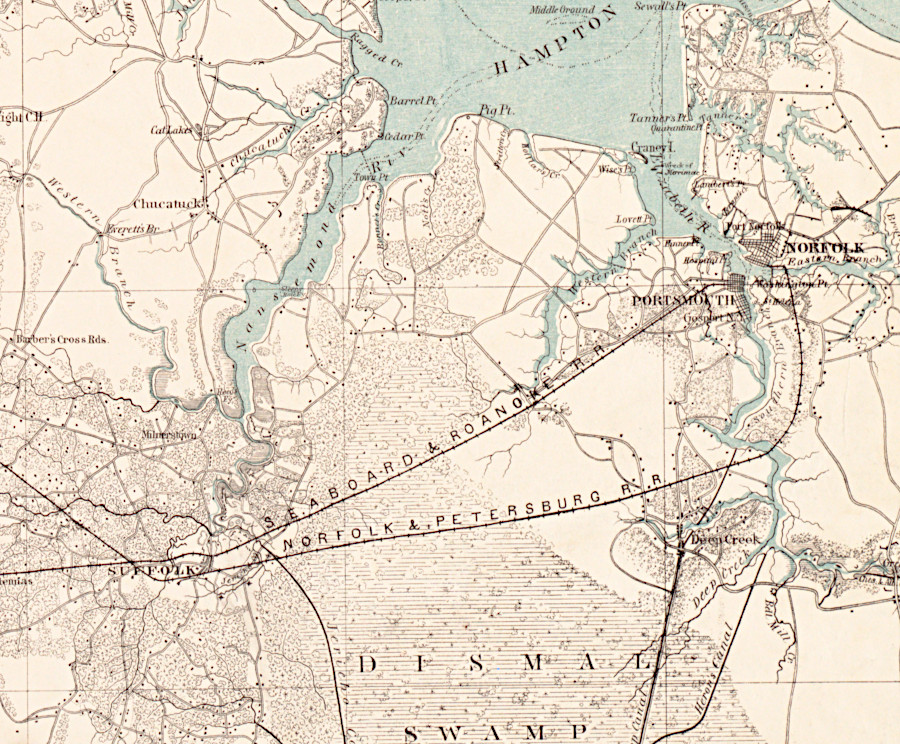Norfolk and Petersburg Railroad

the Norfolk and Petersburg Railroad connected a Hampton Roads port directly to the Piedmont trade, competing with Fall Line ports at Petersburg and Richmond
Source: Library of Congress, Map showing route of Norfolk & Petersburg Rail Road and its connections with Ohio & Mississippi Rivers (1858)
The General Assembly finally granted a charter for the Norfolk and Petersburg Railroad on March 17, 1851. The state legislature required that it charge at least the same price as the Seaboard and Roanoke Railroad for freight and passengers, eastward from where the two railroads met. That requirement protected the existing Seaboard and Roanoke Railroad from prince competition.1
The railroad connection to Petersburg enabled Norfolk to compete with Portsmouth, Petersburg, and Richmond. Cargo could be brought from the Fall Line to a deepwater port almost at the mouth of the Chesapeake Bay, minimizing the time ships had to spend sailing up the James River to Petersburg/Richmond or up the York River to West Point.

Petersburg and Portsmouth officials delayed approval of a charter for the Norfolk and Petersburg Railroad, to block competition
Source: Library of Congress, Railroad map of the eastern, western and northern states, and Canada (1859)
William Mahone engineered the construction of the Norfolk and Petersburg Railroad between 1853-58. He built across the Dismal Swamp between Portsmouth-Suffolk by creating a corduroy roadbed, laying trees perpendicular to the line of the track for 12 miles. That roadbed is still used by the Norfolk Southern.
He designed a 52-mile stretch of tangent (straight) track from Suffolk northwest to Petersburg. It is the longest tangent track in Virginia; all other railroads included more curves to accommodate local topography, while Mahone was able take advantage of the flat Coastal Plan with minimal topographic relief. The longest stretch of straight mainline railroad track in the United States is also on the Coastal Plain, built by the Carolina Central Railway going inland from the Wilmington, North Carolina port.2
Mahone was a colorful character. Supposedly he and his wife Otelia named the depots of the railroad which were constructed along the route to supply water and wood for the steam locomotives. Their inspiration for town names was reportedly Sir Walter Scott and his novels, though the source of Zuni's name remains a mystery. The Disputanta depot got its name, according to lore, because William and Otelia Mahone could not agree on name for that location.3

the Norfolk and Petersburg Railroad led to the creation of towns such as Disputanta and Ivor
Source: Library of Congress, Hare's map of the vicinity of Richmond, and Peninsular campaign in Virginia (by J. Knowles Hare, 1862)
Mahone built a freight terminal at the mouth of Newtown Creek, filling in most of the creek in the process. Tracks ran down Water Street in Norfolk, next to the wharves on the waterfront.4
In Petersburg, passengers using the Norfolk and Petersburg Railroad stayed at the Bollingbrook Hotel. Customers traveling the Petersburg Railroad typically used the Jarrett's Hotel.5

before construction of the Norfolk and Petersburg Railroad, the Portsmouth and Roanoke Railroad was the only railroad link to ports in Hampton Roads
Source: Library of Congress, The American atlas, exhibiting the post offices, post roads, rail roads, canals, and the physical & political divisions of the United States of North America (by John Arrowsmith, 1839)

after 1858, Norfolk and Portsmouth had separate railroad connections to inland trade
Source: Library of Congress, Hare's map of the vicinity of Richmond, and Peninsular campaign in Virginia (by J. Knowles Hare, 1862)
During the Civil War, the Norfolk end of the line was seized by Union forces in early 1862. Confederate General Longstreet brought a large force to Isle of Wight County in April 1863, in what led to a siege at Suffolk. He notified the Engineer Bureau that his move east of the Blackwater River would create an opportunity to collect "iron" (rails) from the Norfolk and Petersburg Railroad.6
In 1867, the Norfolk and Petersburg Railroad became part of the Atlantic, Mississippi & Ohio Railroad, united with the South Side Railroad and the Virginia and Tennessee Railroad to create a trunkline from Bristol to the Elizabeth River.7

the route of the Norfolk and Petersburg Railroad is used today by Norfolk Southern and Amtrak
Source: Virginia Department of Rail and Public Transportation, Railroad map of the eastern, western and northern states, and Canada


the Norfolk and Petersburg Railroad 52-mile tangent track is straighter than US 460 today
Source: New York Public Library, Map of Atlantic, Mississippi & Ohio railroad and ESRI, ArcGIS Online
Links
References
1. "An Act to Incorporate the Norfolk and Peterburg Railroad," Acts of the General Assembly of the State of Virginia Passed at the Session of 1850-51, Commonwealth of Virginia, 1851, p.60, https://books.google.com/books?id=Y_FQAQAAMAAJ (last checked May 17, 2020)
2. "Civil Engineer, Railroad Builder, Family," Mahone's Tavern and Museum, https://www.mahonestavern.org/page/civil-engineer,-railroad-builder,-family/; "Carolina Central Railway," NCpedia, https://www.ncpedia.org/carolina-central-railway (last checked May 16, 2020)
3. "What's in a name? | Disputanta," The Virginian-Pilot, April 23, 2012, https://www.pilotonline.com/history/article_59d16007-ea64-5144-91aa-633c75f994f1.html (last checked May 16, 2020)
4. "Mahone's Norfolk and Petersburg Railroad," Norfolk Virginia History, http://www.norfolkhistory.com/ngmahnandprr.htm (last checked May 16, 2020)
5. "Petersburg's Railroads - Norfolk and Petersburg Railroad," Random Thoughts on History blog, http://randomthoughtsonhistory.blogspot.com/2018/03/petersburgs-railroads-norfolk-and.html (last checked May 17, 2020)
6. summary entry of letter from General James Longstreet to Engineer Bureau, April 6, 1863, in Confederate Railroads, http://www.csa-railroads.com/Essays/Orignial%20Docs/NA/NA,_ENGR_4-6-63.htm (last checked August 21, 2020)
7. Peter C. Luebke, "William Mahone (1826–1895)," Encyclopedia Virginia, Virginia Humanities, July 19, 2016, https://www.encyclopediavirginia.org/Mahone_William_1826-1895 (last checked May 16, 2020)

the Norfolk and Petersburg Railroad built across the Southern and Eastern branches of the Elizabeth River to reach Norfolk
Source: Norman B. Leventhal Map & Education Center Collection, Military map of south-eastern Virginia (c.1862)
Railroads of Virginia
Virginia Places








